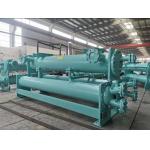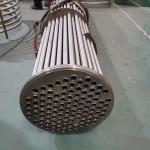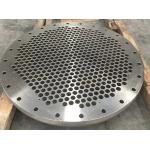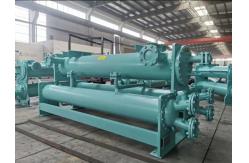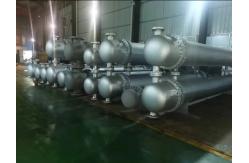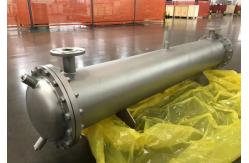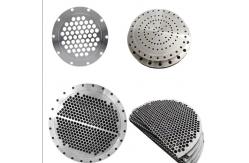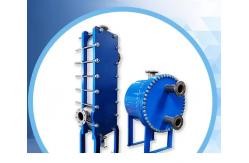Manufacturer of Customization Titanium Heat Exchangers in Chemical
Energy Storage Chemical energy storage refers to the process of storing energy in
the form of chemical compounds and releasing it through chemical
reactions. This storage method has significant potential,
especially in renewable energy sectors (such as solar and wind) and
energy storage systems. Chemical energy storage systems include
various technologies like hydrogen storage, lithium-ion batteries,
and more. Heat exchangers play a critical role in these systems,
especially in processes that involve heat transfer and temperature
regulation. Role of Heat Exchangers in Chemical Energy StorageA heat exchanger is a device used to transfer heat between two or
more fluids. In chemical energy storage systems, heat exchangers
serve key functions in several ways: Temperature Control and Reaction Regulation: In certain chemical energy storage systems, chemical reactions
(such as hydrogen synthesis and decomposition, lithium battery
charge/discharge, etc.) are accompanied by temperature changes.
Here, heat exchangers help transfer the heat generated or absorbed
during the reaction to maintain the optimal reaction temperature.
For example, in hydrogen storage systems (such as hydrogen
synthesis or fuel cell operations), heat exchangers regulate the
system’s temperature to ensure the chemical reaction does not
overheat or cool down excessively, which would affect energy
release and efficiency. Efficiency Enhancement: In many storage technologies, such as thermochemical energy
storage (TCES) systems, heat exchangers are used to improve the
energy storage and release efficiency. By controlling the
temperature differential and heat flow, heat exchangers can
maximize the utilization of thermal energy and minimize energy
loss. In thermochemical storage systems, heat exchangers are used
to transfer thermal energy from reactants to storage media (e.g.,
thermal salts, metal hydrides), which is then released when
required. Enhancing Chemical Reaction Kinetics: Some chemical energy storage technologies require specific
temperature conditions for efficient chemical reactions. Heat
exchangers provide precise temperature control. For example, in
lithium-ion batteries, if the temperature is too high or too low,
it can affect the battery's performance and lifespan. Heat
exchangers help ensure that the battery operates within its optimal
temperature range.
Applications of Heat Exchangers in Common Chemical Energy Storage
TechnologiesHydrogen Storage Systems (Power-to-Gas): Hydrogen storage is a technology that converts electrical energy
into hydrogen, which can then be stored and later converted back
into electricity. In hydrogen production and storage, heat
exchangers control reaction temperatures to ensure the efficiency
and safety of processes like electrolysis. They also play a role in
hydrogen compression and liquefaction, transferring heat out of the
gas to ensure stability during these processes. Thermochemical Energy Storage (TCES): In thermochemical energy storage systems, chemical reactions are
used to store and release energy. Heat exchangers are crucial in
controlling the reaction temperature and regulating the reaction
rate. For example, in metal hydride hydrogen absorption/desorption
reactions, heat exchangers can absorb heat and store it, then
release the heat when needed for energy production. Sodium-Sulfur Batteries (NaS Batteries): Sodium-sulfur batteries are a type of high-temperature energy
storage system, operating at temperatures around 300–350°C. Heat
exchangers are essential in these batteries to remove heat and
transfer it to the surrounding environment, maintaining the optimal
temperature for the chemical reactions within the battery. Molten Salt Energy Storage: In concentrated solar power (CSP) systems, molten salts are often
used as heat storage media. Heat exchangers in molten salt storage
systems are vital for transferring heat from the molten salts to
steam generators, which are then used to drive turbines for
electricity generation. Heat exchangers ensure efficient heat
transfer and prevent overheating or uneven temperature distribution
in the system.
Types of Heat ExchangersDifferent chemical energy storage technologies have varying demands
for heat exchangers, so various types are used depending on the
application. Common types of heat exchangers include: - Shell-and-Tube Heat Exchanger: Consists of a shell and a series of tubes through which fluids
flow. This type is widely used in large-scale energy storage
systems.
- Plate Heat Exchanger: Made up of multiple stacked metal plates, this type is more
compact and typically used for systems requiring rapid heat
transfer or lower fluid temperatures, such as small-scale chemical
energy storage devices.
- Fin-Tube Heat Exchanger: Features fins attached to tubes to increase the heat transfer
surface area. This type is used in systems requiring high heat
dissipation.
- Air-Cooled Heat Exchanger: Utilizes air to cool the fluids within the system, often used in
systems where liquid or other cooling media are less desirable or
more expensive.
ConclusionHeat exchangers play a crucial role in chemical energy storage
systems by regulating reaction temperatures, improving energy
conversion efficiency, and ensuring the stability of the storage
process. As new energy storage technologies continue to develop,
the design and application of heat exchangers also evolve to meet
the thermal management needs of different storage systems. |

